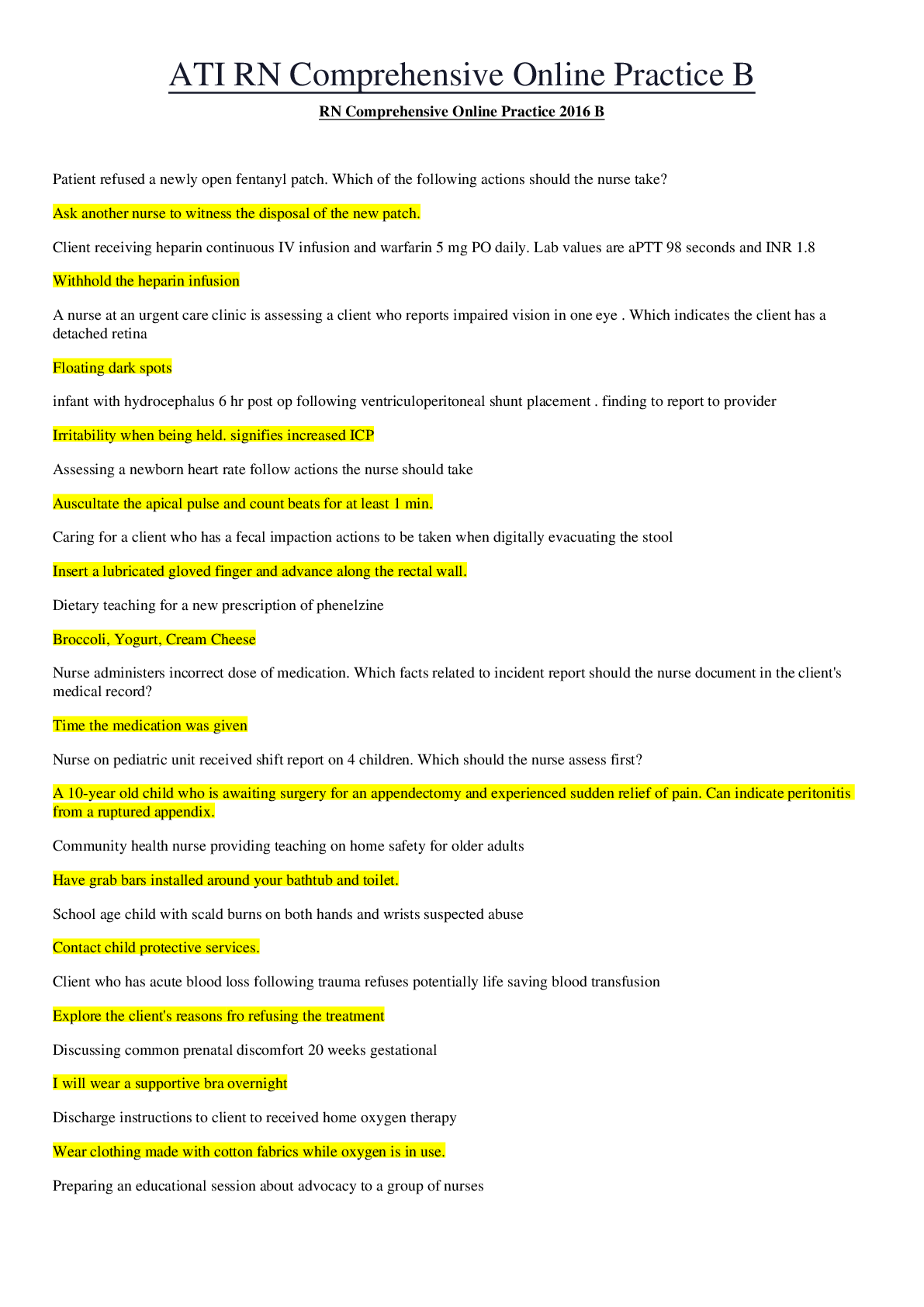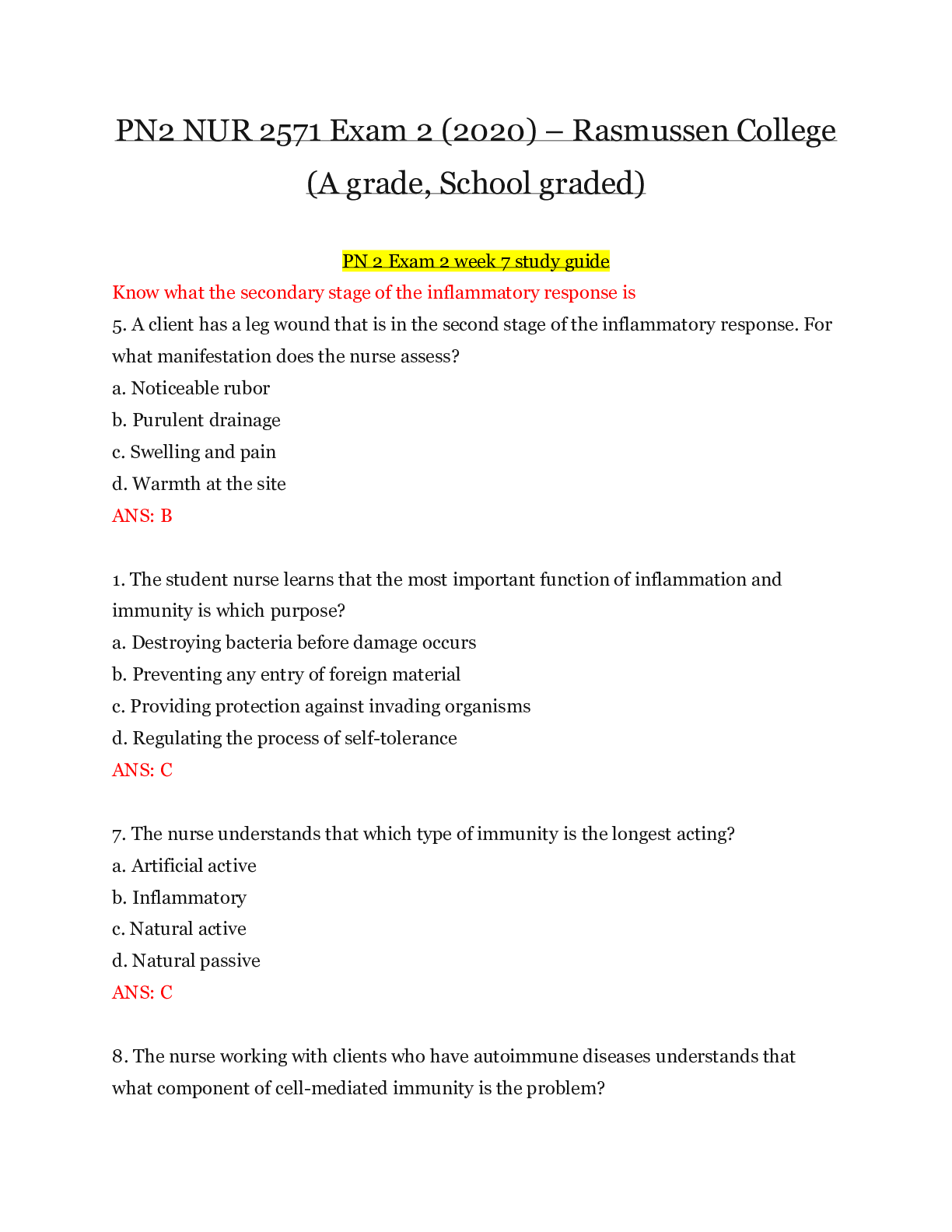Anatomy > EXAM > HIM 1130 - G150 Final exam fall 2019/2020 – Rasmussen College ( Grade A ) | HIM1130-G150 Final exa (All)
HIM 1130 - G150 Final exam fall 2019/2020 – Rasmussen College ( Grade A ) | HIM1130-G150 Final exam fall 2019/2020
Document Content and Description Below
HIM 1130 - G150 Final exam fall 2019 – Rasmussen College ( Grade A ) Question 1 1. What statement is true of type A+ blood type? A. It will only have type A antibodies in the plasma ... B. It will have type A and B antibodies in the plasma C. It will have type A antigen and not the Rh antigen on the surface of its erythrocytes D. It will have type A antigen and Rh antigen located on the surface of its erythrocytes 1 points Question 2 1. What endocrine gland secretes a hormone that increases the blood calcium levels? A. Thyroid gland B. Pancreas C. Parathyroid gland D. Adrenal glands 1 points Question 3 1. This type of tissues lines hollow organs, covers the outer surface of the skin and functions to provide protection or allow for absorption and secretion of substances? A. Epithelial tissue B. Muscular tissue C. Connective tissue D. Nerve tissue 1 points Question 4 1. What is not an obstacle sperm face within the female reproductive system? A. Gravity B. Acidic pH levels within the vagina C. Cilia within the fallopian tubes D. Female’s immune system cells 1 points Question 5 1. When the immune system is weaken and cannot optimally perform is normal function, what type of immune disorder is this called? A. Immunodeficiency B. Hypersensitivity C. Autoimmune D. Phagocytosis 1 points Question 6 1. This type of organic compound is utilized in structural support of cells, in the production of enzymes and hormones and is a main component in the contractile units of a muscle cells? A. Carbohydrates B. Nucleic acids C. Proteins D. Lipids 1 points Question 7 1. What is NOT true of the plasma (cell) membrane? A. It defines the boundaries of the cell B. It allows for the movement of certain substances in and out of the cell C. It is mainly composed of lipids (fats) D. Carbohydrate form receptors and channels that are scattered throughout the membrane 1 points Question 8 1. What blood vessel carries blood away from the heart out to the body and typically carries oxygenated blood? A. Artery B. Capillary C. Venule D. Vein 1 points Question 9 1. What part of the nephron is involved in the glomerular filtration process of urine formation? A. Renal tubules B. Collecting duct C. Renal corpuscle D. Renal pelvis 1 points Question 10 1. Which heart chamber receives deoxygenated blood from the body? A. Left atrium B. Left ventricle C. Right atrium D. Right ventricle 1 points Question 11 1. This type of organic compound is utilized as structural support to cell membranes, acts as a reservoir (storage) unit for energy, and is involved in the production of steroids? A. Carbohydrates B. Proteins C. Nucleic acids D. Lipids 1 points Question 12 1. The pancreas makes bile and stores in the gallbladder, which assists in the digestion of lipids (fat)? True False 1 points Question 13 1. What upper extremity bone is the arrow pointing to? A. Sternum B. Ulna C. Radius D. Humerus 1 points Question 14 1. Physiology refers to the study of the body’s structure while anatomy refers to the study of the body’s function? True False 1 points Question 15 1. The spinal cord transmits information from the body to the brain only? True False 1 points Question 16 1. What lobe of the cerebrum controls our consciousness, intelligence and conscious movement of muscles? A. Occipital lobe B. Temporal lobe C. Parietal lobe D. Frontal lobe 1 points Question 17 1. What blood vessel carries blood back to the heart? A. Arteriole B. Artery C. Capillary D. Vein 1 points Question 18 1. What organ will produce estrogen and progesterone in the female reproductive system? A. Fallopian tubes B. Ovary C. Vagina D. Uterus 1 points Question 19 1. What is NOT true of the male reproductive system? A. Sperm constitutes the majority of semen volume B. Sperm is matures and is stored in the epididymis C. The testes produce sperm D. The testes produce testosterone 1 points Question 20 1. This structure acts as the in between structure between the mother’s blood and baby’s blood? A. Endometrium B. Umbilical cord C. Yolk sac D. Placenta 1 points Question 21 1. What type of blood cell assists in transporting oxygen throughout the body? A. Thrombocytes B. Leukocytes C. Neutrophils D. Erythrocytes 1 points Question 22 1. The stomach main function is to mechanical digest food into a substance called chyme? True False 1 points Question 23 1. This region of the brain is involved in coordinated movement of large muscle groups, posture, and balance? A. Cerebellum B. Brainstem C. Diencephalon D. Cerebrum 1 points Question 24 1. What statement is true of the skin? A. The epidermis and dermis contains blood vessels B. The epidermis layer is continuously shedding old, dead skin cells and replacing them with new cells C. The epidermis has blood vessels within it D. Skin cancer originates in the dermis 1 points Question 25 1. What is NOT a classic (or cardinal) sign of inflammation? A. Fever B. Pain C. Swelling D. Redness 1 points Question 26 1. The AV bundle, also called the pacemaker, assists in setting the heart rate of the heart? True False 1 points Question 27 1. For an individual to express an autosomal dominant genetic disorder they will have to inherit both copies of mutated gene? True False 1 points Question 28 1. What statement is NOT true about hemostasis? A. Vascular spasm is a step in the homeostasis process B. It is a process to stop bleeding C. White blood cells are a vital component to hemostasis D. A blood clot is ultimately formed 1 points Question 29 1. What statement is NOT true of cellular respiration? A. Lipids and oxygen are utilized in aerobic (with oxygen) respiration as the primary source to produce ATP B. Aerobic (with oxygen) respiration occurs within the mitochondria of cells C. Aerobic (with oxygen) respiration requires proper function of the cardiovascular, respiratory, and digestive systems D. Anaerobic (without oxygen) respiration process will not produce enough ATP to sustain life 1 points Question 30 1. This type of tissue allows for allows for the transmission of electrical impulses that provide communication signals with the body? A. Muscular tissue B. Connective tissue C. Nerve tissue D. Epithelial tissue 1 points Question 31 1. The ureter transport urine from the bladder to the outside or external portion of the body? True False 1 points Question 32 1. What lower extremity muscle is the arrow pointing to? A. Hamstring B. Quadriceps C. Gastrocnemius D. Biceps brachii 1 points Question 33 1. This heart chamber will pump oxygenated blood out to the body? A. Left atrium B. Right atrium C. Left ventricle D. Right ventricle 1 points Question 34 1. Where does gas exchange occur within the respiratory system? A. Alveoli B. Trachea C. Bronchi D. Bronchioles 1 points Question 35 1. Which endocrine gland secretes hormones that help the body adapt to stressful situations and release hormones that can reduce inflammation? A. Adrenal gland B. Thyroid gland C. Pineal gland D. Pancreas 1 points Question 36 1. This organelle is responsible for producing our body’s energy source, ATP? A. Mitochondria B. Ribosomes C. Lysosomes D. Nucleus 1 points Question 37 1. Specific immunity is more effective when it has been previously been exposed to a specific bacteria or virus? True False 1 points Question 38 1. The myocardium of the heart contains the heart muscle that allows for muscle contraction? True False 1 points Question 39 1. Where is our body’s DNA, genetic material, located? A. Nucleus B. Mitochondria C. Ribosome D. Cell membrane 1 points Question 40 1. What muscle is the arrow pointing to? A. Pectoralis major B. Triceps brachii C. Biceps brachii D. Deltoid 1 points Question 41 1. This nutrient is the primary source of energy (ATP) production for the body? A. Proteins B. Vitamins C. Lipids D. Carbohydrates 1 points Question 42 1. The sympathetic nervous system will cause an increase to the heart rate, respiration rate, and cause the pupils to dilate? True False 1 points Question 43 1. What is not a characteristic of the eye? A. Contains specialized cells called rods and cones to allow for vision B. The lens cannot change shape or thickness C. Refracts (bend) the incoming light on the retina D. The sclera is the “white” of the eye 1 points Question 44 1. Blood cell production is a function of the skeletal system? True False 1 points Question 45 1. When a person contracts and gets a cold or infection, what type of immunity is this? A. Natural active immunity B. Natural passive immunity C. Artificial passive immunity D. Artificial active immunity 1 points Question 46 1. Which hormone controls the body’s metabolism? A. Estrogen B. Melatonin hormone C. Insulin D. Thyroid hormone 1 points Question 47 1. The processes of diffusion and osmosis require energy, ATP, for it to occur? True False 1 points Question 48 1. Fertilization of an egg typically occurs here (first answer), while implantation of a fertilized egg occurs here (second answer)? A. Ovary, vagina B. Fallopian tubes, vagina C. Fallopian tubes, uterus D. Ovary, uterus 1 points Question 49 1. The majority of nutrient absorption occurs in what digestive organ? A. Stomach B. Pancreas C. Small intestine D. Large intestine 1 points Question 50 1. A sarcomere stores calcium within the muscle cell? True False 1 points Question 51 1. The sense of taste and smell both involve the nervous system binding molecules to specialized hair cells in the mouth and nose? True False 1 points Question 52 1. When the immune system overreacts to a normal, non-harmful antigen as in the case of allergies, what type of immune disorder is this called? A. Autoimmune B. Immunodeficiency C. Phagocytosis D. Hypersensitivity 1 points Question 53 1. This type of skin cell is involved in regulating our overall skin tone and color? A. Keratinocyte B. Stem cell C. Macrophage D. Melanocyte 1 points Question 54 1. What is NOT true of the skeletal system? A. Red bone marrow is commonly found in spongy bone within the skeletal system B. The end of long bones is called the epiphysis C. Epiphyseal plates are found in adults D. Calcium, phosphate and collagen fibers are found in the matrix of skeletal tissue 1 points Question 55 1. This region of the brain controls primitive functions of the body such as, respiration rate, heart rate, sneezing, and coughing? A. Cerebellum B. Brainstem C. Frontal lobe D. Cerebrum 1 points Question 56 1. This type of blood vessel allows nutrient exchange between the blood vessel and body’s cells and tissues? A. Vein B. Capillary C. Artery D. Venule 1 points Question 57 1. What posterior arm muscle is the arrow pointing to? A. Biceps brachii B. Masseter C. Triceps brachii D. Pectoralis major 1 points Question 58 1. Cells have to replicate, or make a copy of, its DNA prior to going through mitosis and dividing into two new cells? True False 1 points Question 59 1. This plane divides the body/organ into anterior and posterior sections? A. Sagittal plane B. Frontal plane C. Transverse plane D. Horizontal plane 1 points Question 60 1. A neurotransmitter is a chemical released from the soma (cell body) of the neuron? True False 1 points Question 61 1. It is the inner layer of the vagina that is sloughed off during the uterine (menstrual) cycle? True False 1 points Question 62 1. Calcium is a vital component for muscle contraction to occur? True False 1 points Question 63 1. What is NOT true of atoms? A. It is the electrons that allow for chemical bonding to occur between atoms B. They are formed from electrons, protons, and neutrons C. They form chemical bonds with one another to create compounds D. They can break down into another structure 1 points Question 64 1. The axilla region is medial compared to the nose? True False 1 points Question 65 1. Alleles of a gene can either be dominant or recessive? True False 1 points Question 66 1. The cones of the retina allow for color vision and are found concentrated in an area of the eye called the fovea centralis? True False 1 points Question 67 1. Which term best describes the body maintaining a constant internal balance despite changes in the external environment? A. Homeostasis B. Metabolism C. Set point range D. Physiology 1 points Question 68 1. What lower extremity bone is the arrow pointing to? A. Femur B. Tibia C. Radius D. Humerus 1 points Question 69 1. A permanent tattoo will have ink in which layer or layers of the skin? A. Epidermis and dermis B. Dermis C. Epidermis, dermis and hypodermis D. Epidermis 1 points Question 70 1. This cerebral lobe of the brain is involved in our ability to see? A. Frontal B. Occipital C. Parietal D. Temporal 1 points Question 71 1. The diaphragm and abdominal muscles are the main muscle that initiates the pulmonary respiration process to occur? True False 1 points Question 72 1. What is not a function of inflammation? A. To assist in the clean of cellular debris and pathogens B. Stimulate the process of a fever C. To prevent the spread of pathogens D. Initiate the repair process of the body 1 points Question 73 1. This plane divides the body/organ into superior and inferior sections A. Horizontal plane B. Sagittal plane C. Frontal plane D. Transverse plane 1 points Question 74 1. The hormone insulin increases blood glucose (sugar) levels. True False 1 points Question 75 1. Which type of joint has the most range of motion? A. Synovial joints B. Fibrous joints C. Cartilaginous joints D. Arthrology joints 1 points Click Save and Submit to save and submit. Click Save All Answers to save all answers. [Show More]
Last updated: 2 years ago
Preview 1 out of 31 pages

Buy this document to get the full access instantly
Instant Download Access after purchase
Buy NowInstant download
We Accept:

Reviews( 0 )
$16.50
Can't find what you want? Try our AI powered Search
Document information
Connected school, study & course
About the document
Uploaded On
Jul 04, 2020
Number of pages
31
Written in
Additional information
This document has been written for:
Uploaded
Jul 04, 2020
Downloads
0
Views
71








 – University of the People.png)

















